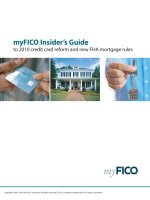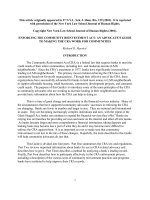Mortgage encyclopedia an authoritative guide to mortgage programs, practices, prices and pitfalls
Bạn đang xem bản rút gọn của tài liệu. Xem và tải ngay bản đầy đủ của tài liệu tại đây (1.48 MB, 337 trang )
The Mortgage
Encyclopedia
This page intentionally left blank.
The Mortgage
Encyclopedia
An Authoritative Guide to Mortgage
Programs, Practices, Prices, and Pitfalls
Jack Guttentag
“The Mortgage Professor”
McGraw-Hill
New York Chicago San Francisco Lisbon
London Madrid Mexico City Milan New Delhi
San Juan Seoul Singapore Sydney Toronto
Copyright © 2004 by Jack Guttentag. All rights reserved. Manufactured in the United States
of America. Except as permitted under the United States Copyright Act of 1976, no part of
this publication may be reproduced or distributed in any form or by any means, or stored in a
database or retrieval system, without the prior written permission of the publisher.
0-07-145849-2
The material in this eBook also appears in the print version of this title: 0-07-142165-3.
All trademarks are trademarks of their respective owners. Rather than put a trademark
symbol after every occurrence of a trademarked name, we use names in an editorial fashion
only, and to the benefit of the trademark owner, with no intention of infringement of the
trademark. Where such designations appear in this book, they have been printed with initial
caps. McGraw-Hill eBooks are available at special quantity discounts to use as premiums
and sales promotions, or for use in corporate training programs. For more information, please
contact George Hoare, Special Sales, at or (212) 904-4069.
TERMS OF USE
This is a copyrighted work and The McGraw-Hill Companies, Inc. (“McGraw-Hill”) and its
licensors reserve all rights in and to the work. Use of this work is subject to these terms.
Except as permitted under the Copyright Act of 1976 and the right to store and retrieve one
copy of the work, you may not decompile, disassemble, reverse engineer, reproduce, modify,
create derivative works based upon, transmit, distribute, disseminate, sell, publish or
sublicense the work or any part of it without McGraw-Hill’s prior consent. You may use the
work for your own noncommercial and personal use; any other use of the work is strictly
prohibited. Your right to use the work may be terminated if you fail to comply with these
terms.
THE WORK IS PROVIDED “AS IS.” McGRAW-HILL AND ITS LICENSORS MAKE
NO GUARANTEES OR WARRANTIES AS TO THE ACCURACY, ADEQUACY OR
COMPLETENESS OF OR RESULTS TO BE OBTAINED FROM USING THE WORK,
INCLUDING ANY INFORMATION THAT CAN BE ACCESSED THROUGH THE
WORK VIA HYPERLINK OR OTHERWISE, AND EXPRESSLY DISCLAIM ANY
WARRANTY, EXPRESS OR IMPLIED, INCLUDING BUT NOT LIMITED TO IMPLIED
WARRANTIES OF MERCHANTABILITY OR FITNESS FOR A PARTICULAR
PURPOSE. McGraw-Hill and its licensors do not warrant or guarantee that the functions
contained in the work will meet your requirements or that its operation will be uninterrupted
or error free. Neither McGraw-Hill nor its licensors shall be liable to you or anyone else for
any inaccuracy, error or omission, regardless of cause, in the work or for any damages
resulting therefrom. McGraw-Hill has no responsibility for the content of any information
accessed through the work. Under no circumstances shall McGraw-Hill and/or its licensors
be liable for any indirect, incidental, special, punitive, consequential or similar damages that
result from the use of or inability to use the work, even if any of them has been advised of
the possibility of such damages. This limitation of liability shall apply to any claim or cause
whatsoever whether such claim or cause arises in contract, tort or otherwise.
DOI: 10.1036/0071458492
������������
Want to learn more?
We hope you enjoy this
McGraw-Hill eBook! If
you’d like more information about this book,
its author, or related books and websites,
please click here.
For more information about this title, click here
Topics
A
A-Credit
Acceleration Clause
Accrued Interest
Adjustable Rate Mortgage (ARM)
Adjustment Interval
Affordability
Agreement of Sale
Alternative Documentation
Amortization
Annual Percentage Rate (APR)
Application
Application Fee
Appraisal
Appraisal Fee
Appraiser
Approval
APR
ARM
Assignment
Assumable Mortgage
Assumption
Auction Sites
Authorized User
Automated Underwriting
Automated Underwriting System
v
1
1
1
1
12
13
15
15
16
19
22
22
22
22
22
23
23
23
23
23
27
27
27
27
27
Topics
B
Balance
Balloon
Balloon Mortgage
Bimonthly Mortgage
Biweekly Mortgage
Bridge Loan
Builder-Financed Construction
27
28
28
29
29
30
31
C
Cap
Cash-Out Refi
Closing
Closing Costs
Closing Date
Co-Borrowers
COFI
Conforming Mortgage
Construction Financing
Contract Chicanery
Conversion Option
Correspondent Lender
Co-Signing
Cost-of-Savings Index (COSI)
Credit Report
Credit Score
Cumulative Interest
Current Index Value
31
31
32
32
32
33
36
36
36
39
39
39
39
40
40
41
45
46
D
Deadbeat
Debt Consolidation
Deed in Lieu of Foreclosure
Default
Deferred Interest
vi
46
46
48
48
48
Topics
Delinquency
Demand Clause
Direct Lender
Discount Points
Discretionary ARM
Documentation Requirements
Down Payment
“Dual-Apper”
Dual Index Mortgage
Due-on-Sale Clause
48
48
49
49
49
49
51
58
58
58
E
Effective Rate
80/10/10 and 80/15/5 Loan Plans
Equity
Escrow Account
59
59
59
59
F
Fallout
Fannie Mae
FHA Mortgage
FICO Score
Financing Points
First Mortgage
Fixed-Rate Mortgage (FRM)
Float
Float-Down
Forbearance Agreement
Forclosure
Freddie Mac
Fully Amortizing Payment
Fully Indexed Rate
61
61
61
64
64
64
64
65
65
65
65
65
65
65
G
Generic Prices
Gift of Equity
66
66
vii
Topics
Good Faith Estimate (GFE)
Government National Mortgage
Association (GNMA)
Grace Period
Graduated Payment Mortgage (GPM)
66
66
66
66
H
Hazard Insurance
Historical Scenario
Homebuyer Protection Plan
Home Equity Conversion Mortgage (HECM)
Home Equity Line
Home Equity Line of Credit (HELOC)
Home Equity Loan
Home Keeper
Homeowner’s Equity
Housing Bank
Housing Expense
Housing Expense Ratio
Housing Investment
67
67
67
67
67
67
71
71
71
71
73
73
73
I
Indexed ARMs
Initial Interest Rate
Initial Rate Period
Interest Accrual Period
Interest Cost (IC)
Interest Due
Interest-Only Mortgage (Option)
Interest Payment
Interest Rate
Interest Rate Adjustment Period
Interest Rate Ceiling
Interest Rate Decrease Cap
Interest Rate Floor
viii
76
76
77
77
77
78
78
81
82
83
83
83
84
Topics
Interest Rate Increase Cap
Interest Rate Index
Internet Mortgages
84
84
84
J
Jumbo Mortgage
Junk Fees
84
84
L
Late Fees
Late Payment
Lead-Generation Sites
Lender
Loan Amount
Loan “Flipping”
Loan Officer
Loan Provider
Loan-to-Value Ratio (LTV)
Lock Commitment Letter
Locking the Loan
Lock-Jumper
Lock Period
85
85
85
87
87
87
88
88
88
88
88
94
94
M
Mandatory Disclosure
Manufactured Home
Margin
Market Niche
Maturity
Maximum Loan Amount
Maximum Loan-to-Value Ratio
Maximum Lock
Minimum Down Payment
Monthly Debt Service
Monthly Housing Expense
Monthly Total Expense
ix
94
95
98
98
98
98
98
99
99
99
99
99
Topics
Mortgage
Mortgage Auction Site
Mortgage Bank
Mortgage Broker
Mortgage Company
Mortgage Equations
Mortgage Insurance
Mortgage Insurance Premium
Mortgage Lender
Mortgage Payment
Mortgage Price
Mortgage Price Quotes
Mortgage Program
Mortgage Referrals
Mortgage Scams and Tricks
Mortgage Shopping
99
100
100
100
103
103
105
105
105
106
106
107
110
110
112
123
N
Negative Amortization
Negative Amortization Cap
Negative Points
Net Branch
Net Jumping
Nichification
No-Asset Loan
No-Change Scenario
No-Cost Mortgage
No-Income Loan
Non-Conforming Mortgage
Non-Permanent Resident Alien
No-Ratio Loan
Note
x
133
133
133
133
133
133
137
137
137
138
138
138
139
139
Topics
O
100% Loan
125% Loan
Origination Fee
Overage
139
139
139
139
P
Partial Prepayments (or Paying Off Early)
Pay-Down Magic
Payment Adjustment Cap
Payment Adjustment Interval
Payment Period
Payment Problems
Payment Rate
Payment Shock
Payoff Month
Per Diem Interest
Permanent Buydown
Pipeline Risk
PITI
PMI
Points
Portable Mortgage
Portfolio Lender
Pre-Approval
Predatory Lending
Prepayment
Prepayment Penalty
Pre-Qualification
Price Gouging
Primary Residence
Principal
xi
141
146
147
147
148
148
151
152
152
152
152
152
153
153
153
156
158
158
158
162
163
165
165
165
165
Topics
Principal Limit
Private Mortgage Insurance (PMI)
Processing
166
166
172
Q
Qualification
Qualification Rate
Qualification Ratios
Qualification Requirements
173
179
179
179
R
Rate
Rate/Point Break-Even
Rate/Point Options
Rate Protection
Rebate
Recast Clause
Referral Site
Refinance
Required Cash
RESPA
Retail Lender
Reverse Mortgage
179
179
180
180
180
180
180
181
190
190
194
194
S
Scheduled Mortgage Payment
Second Mortgage
Secondary Mortgage Markets
Self-Employed Borrower
Seller Contribution
Servicing
Servicing Agent
Settlement Costs
Shared Appreciation Mortgage (SAM)
Shopping Site
Short Sale
xii
208
208
213
217
217
217
222
222
226
227
227
Topics
Silent Second
Simple Interest
Simple Interest Biweekly Mortgage
Simple Interest Mortgage
Single-Lender Web Site
Stated Assets
Stated Income
Streamlined Refinancing
Subordinate Financing
Subordination Policy
Sub-Prime Borrower
Sub-Prime Lender
Swing Loan
227
227
228
228
228
228
228
229
229
229
229
229
230
T
Tax Deductibility (of Interest and Points)
Teaser Rate
Temporary Buydown
Temporary Lender
Term
3/2 Down Payment
Title Insurance
Total Annual Loan Costs (TALC)
Total Expense Ratio
Total Housing Expense
Total Interest Payments
Truth in Lending (TIL)
12 MTA
230
231
231
233
233
237
237
240
240
241
241
241
243
U
Underage
Underwriting
Underwriting Requirements
Upfront Mortgage Broker (UMB)
Upfront Mortgage Lender
xiii
243
244
244
244
245
Topics
V
VA Mortgage
247
W
Waiver of Escrows
Warrantable Condo
Wholesale Lender
Workout Assumption
Worst-Case Scenario
Wrap-Around Mortgage
248
248
248
248
248
249
Y
Yield-Spread Premium
250
Z
Zero Balance
250
Refinance Break-Even Tables
xiv
251
Introduction
F
or all practical purposes, I began writing this book in 1998
when I started writing a weekly newspaper column on mortgages that was syndicated by Inman. In 1999, I started
www.mtgprofessor.com, which pulled the columns together, and
added calculators, spreadsheets, and other materials including a
way for readers to send me questions. I spent a lot of time organizing these materials into a coherent structure, and my thinking about
a book version posited a similar organization.
For that reason, when Richard Narramore of McGraw-Hill
approached me about preparing a book organized in an encyclopedia format, I resisted. But Richard was persistent, and I began to
reconsider. Although I liked the organization on my Web site, I was
forced to admit that my readers had a lot of trouble with it. About a
third of my replies to those who wrote me consisted of referrals to
the Web pages where the answer to their questions would be found.
Many of the questions I receive from consumers reflect what they
have been told by loan officers and mortgage brokers, who don’t
think about mortgages the way I do. As one example, a mortgage
contract may have a provision that allows the borrower to pay only
the interest for some period—“interest-only.” Any mortgage,
whether it is fixed rate or adjustable rate, can have such a provision.
It is an option. But that is not the way it is marketed. Loan officers and
mortgage brokers sell it as a special kind of mortgage, as if there were
fixed-rate, adjustable rate, and interest-only mortgages. Then their
xv
Copyright © 2004 by Jack Guttentag. Click here for terms of use.
Introduction
customers may write me to ask about the advantages and disadvantages of interest-only mortgages compared to those other types.
While this question makes no sense, those who ask it need to learn,
with the least expenditure of time and effort, why it makes no sense.
The encyclopedia A to Z format turns out to be an efficient way to
convey this information, avoiding conflict between the way I perceive a problem and the way many readers perceive it. I see interestonly as an option, many readers see it as a type of mortgage, but we
can both agree that in an encyclopedia it appears under “I.”
I’m known as “The Mortgage Professor.” Often in this book I refer
to my Web site, www.mtgprofessor.com, where you’ll find backup
information, mortgage calculators, and more to help you make the
best decisions about financing or refinancing your real estate.
Acknowledgments
Much of what I know about the home mortgage market I learned
from the 25,000 or so borrowers who have e-mailed questions and
comments to me over the last six years. A number of loan officers
and mortgage brokers have also contributed to my education, often
by being combative, occasionally for good reason. Catherine Coy,
who brokers in Los Angeles, has been particularly helpful in improving my understanding of what goes on in the mortgage trenches. My
wife Doris has been quietly supportive, as she has been throughout
the best years of my life.
—Jack Guttentag
xvi
Copyright © 2004 by Jack Guttentag. Click here for terms of use.
The Mortgage
Encyclopedia
This page intentionally left blank.
A-Credit A borrower with the best credit rating, deserving of the lowest
prices that lenders offer.
Most lenders require a FICO score above 720. See Credit Score/Use
of FICO Scores by Lenders. There is seldom any payoff for being above
the A-credit threshold, but you pay a penalty for being below it.
Acceleration Clause A contractual provision that gives the lender the
right to demand repayment of the entire loan balance in the event that
the borrower violates one or more clauses in the note.
Such clauses may include sale of the property, failure to make
timely payments, or provision of false information.
I have never seen a note that did not have such a clause.
Borrowers need not concern themselves with it except where the
lender has discretion to exercise it without conditions. This would be
referred to as a “demand feature,” and it would be flagged on the
Truth in Lending Disclosure Statement. If that statement shows
“This loan has a Demand Feature…,” the note should be read with
care. See Demand Clause.
Accrued Interest Interest that is earned but not paid, adding to the
amount owed.
For example, if the monthly interest due on a loan is $600 and the
borrower pays only $500, $100 is added to the amount owed by the
borrower. The $100 is the accrued interest. On a mortgage, accrued
interest is usually referred to as Negative Amortization.
Adjustable Rate Mortgage (ARM) A mortgage on which the interest
rate can be changed by the lender.
While ARM contracts in many countries abroad allow rate
changes at the lender’s discretion (Discretionary ARMs), in the U.S.
rate changes on ARMs are mechanical. They are based on changes in
1
Copyright © 2004 by Jack Guttentag. Click here for terms of use.
Adjustable Rate Mortgage (ARM)
an interest rate index over which the lender has no control.
Henceforth, all references are to such Indexed ARMs.
Reasons for Selecting an ARM: Borrowers may select an ARM in preference to a fixed rate mortgage (FRM) for three reasons:
• To qualify: they need an ARM to qualify for the loan they
want.
• To take advantage of low initial rates on ARMs and their own
short time horizon: they expect to be out of their house before
the initial rate period ends.
• To gamble on future interest rates: they expect that they will
pay less on the ARM over the life of the loan and are prepared
to take the risk that rising interest rates will cause them to pay
more.
I will return to these reasons later.
How the Interest Rate on an ARM Is Determined: There are two phases
in the life of an ARM. During the first phase, the interest rate is fixed,
just as it is on an FRM. The difference is that on an FRM the rate is
fixed for the term of the loan, whereas on an ARM it is fixed for a
shorter period. The period ranges from one month to 10 years.
At the end of the initial rate period, the ARM rate is adjusted. The
adjustment rule is that the new rate will equal the most recent value
of a specified interest rate index, plus a margin. For example, if the
index is 5% when the initial rate period ends, and the margin is
2.75%, the new rate will be 7.75%. The rule, however, is subject to
two conditions.
The first condition is that the increase from the previous rate cannot exceed any rate adjustment cap specified in the ARM contract.
An adjustment cap, usually 1% or 2% but ranging in some cases up
to 5%, limits the size of any interest rate change.
The second condition is that the new rate cannot exceed the contractual maximum rate. Maximum rates are usually five or six percentage points above the initial rate.
During the second phase of an ARM’s life, the interest rate is
adjusted periodically. This period may or may not be the same as the
2
Adjustable Rate Mortgage (ARM)
initial rate period. For example, an ARM with an initial rate period
of five years might adjust annually or monthly after the five-year
period ends.
The Quoted Interest Rate: The rate that is quoted on an ARM, by the
media and by loan providers, is the initial rate—regardless of how
long that rate lasts. When the initial rate period is short, the quoted
rate is a poor indication of interest cost to the borrower. The only significance of the initial rate on a monthly ARM, for example, is that
this rate may be used to calculate the initial payment. See How the
Monthly Payment on an ARM Is Determined.
The Fully Indexed Rate: The index plus margin is called the “fully
indexed rate,” or FIR. The FIR based on the most recent value of the
index at the time the loan is taken out indicates where the ARM rate
may go when the initial rate period ends. If the index rate does not
change, the FIR will become the ARM rate.
For example, assume the initial rate is 4% for one year, the fully
indexed rate is 7%, and the rate adjusts every year subject to a 1%
rate increase cap. If the index value remains the same, the 7% FIR
will be reached at the end of the third year.
The FIR is thus an important piece of information, the more so the
shorter the initial rate period. Nevertheless, it is not a mandated disclosure and loan officers may not have it. They will know the margin and the specific index, however, and the most recent value of the
index can be found on the Internet, as explained below.
ARM Rate Indexes: Every ARM is tied to an interest rate index. An
index has three relevant features:
• Availability
• Level
• Volatility
All the common ARM indexes are readily available from a published source, with the exception of one called the Cost of Savings
Index, or COSI. I would avoid it.
In principle, a lower index is better for a borrower than a higher
one. However, lenders take account of different index levels in set3
Adjustable Rate Mortgage (ARM)
ting the margin. A 3% index with a 2% margin provides the same FIR
as a 2% index with a 3% margin. Assuming volatility is the same,
there is nothing to choose between them.
An index that is relatively stable is better for the borrower than one
that is volatile. The stable index will increase less in a rising rate environment. While it will also decline less in a declining rate environment, borrowers can take advantage of declining rates by refinancing.
The most stable of the more widely-used rate indexes is the 11th
District Cost of Funds Index, referred to as COFI (not “coffee”). Most
of the others are significantly more volatile. These include the
Treasury series of constant (one-, two-, or three-year) maturity, onemonth and six-month Libor, six-month CDs and the Prime Rate.
Another series known as MTA is a 12-month moving average of
the one-year Treasury constant maturity series. MTA is a little more
volatile than COFI but less volatile than the other series.
An ARM should never be selected based on the index alone. That
would be like buying a car based on the tires. But if an overall evaluation (see below) indicates that two ARMs are very close, preference could be given to the one with the more stable index.
Current and historical values of major ARM indexes can be found
on the following Web sites: mortgage-x.com, bankrate.com,
nfsn.com, and hsh.com.
How the Monthly Payment on an ARM Is Determined: ARMs fall into
two major groups that differ in the way in which the monthly payment of principal and interest is determined: fully amortizing ARMs
and negative amortization ARMs.
Fully Amortizing ARMs adjust the monthly payment to be fully
amortizing whenever the interest rate changes. The new payment
will pay off the loan over the period remaining to term if the interest
rate stays the same.
For example, a $100,000 30-year ARM has an initial rate of 5%,
which holds for five years, after which the rate is adjusted every
year. (This is referred to as a “5/1 ARM.”) The payment of $536.83
for the first five years would pay off the loan if the rate stayed at 5%.
In month 61, the rate might increase to, say, 7%. A new payment of
$649.03 is then calculated, at 7% and 25 years, which would pay off
4
Adjustable Rate Mortgage (ARM)
the loan if the rate stayed at 7%. As the rate changes each year thereafter, a new payment is calculated that would pay off the loan over
the remaining period if that rate continued.
Negative Amortization ARMs allow payments that don’t fully cover
the interest. They have one or more of the following features:
• Payment Rate Below the Interest Rate: The payment rate,
which is the interest rate used to calculate the payment, may
be below the actual interest rate. If the payment rate is so low
that the initial payment does not cover the interest, the result
will be negative amortization.
• More Frequent Rate Adjustments than Payment Adjustments:
If, e.g., the rate adjusts every month but the payment adjusts
every year, a large rate increase within the year will lead to
negative amortization.
• Payment Adjustment Caps: If a rate change is large and a
payment adjustment cap limits the size of a change in payment, the result will be negative amortization.
Virtually all ARMs are designed to fully amortize over their term.
This means that negative amortization can only be temporary and at
some point or points in the ARM’s life history the monthly payment
must become fully amortizing.
Two contract provisions are used to assure that negative amortization ARMs pay off at term.
• A recast clause requires that periodically, usually every five
years, the payment must be adjusted to the fully amortizing
level.
• A negative amortization cap is a maximum ratio of loan balance to original loan amount, for example, 110%. If that maximum is reached, the payment is immediately adjusted to the
fully amortizing level, overriding any payment adjustment
cap. In a worse case scenario, the required payment increase
may be very large.
Identifying ARMs: There are no industry standards for identifying
ARMs and practices vary across lenders. Some identify their ARMs
by the index used, e.g., “COFI ARM” or “six-month Libor ARM.”
5









